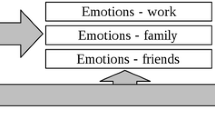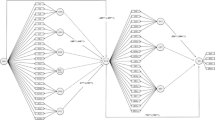Abstract
Past research has found that trait positive affect as measured by the Positive and Negative Affect Schedule (PANAS) and extraversion as measured by the NEO-Five Factor Inventory (NEO-FFI) are highly correlated. We examined the relation between these two measures within the context of three social behaviors. Approximately 4 months before graduation, college seniors entering the job market completed the PANAS and the NEO-FFI and reported on their social activities during college. Three months later, these students were contacted again and described their job search strategies and success at obtaining follow-up job interviews. Trait positive affect scores and extraversion scores were highly correlated and both predicted behavior in each of the three areas investigated. Regression analyses indicated that trait positive affect predicted behavior in all three areas after the effects of extraversion were removed. However, extraversion did not add significantly to predicting behavior in any of the three areas after the effects of trait positive affect were removed. The findings have implications for the conceptual relation between extraversion and trait positive affect.
Similar content being viewed by others
REFERENCES
Barrick, M. R., & Mount, M. K. (1991). The Big Five personality dimensions and job performance: A meta-analysis. Personnel Psychology, 44, 1–26.
Briggs, S. R. (1989). The optimal level of measurement for personality constructs. In D. M. Buss & N. Cantor (Eds.), Personality psychology: Recent trends and emerging directions (pp. 246–260). New York: Springer-Verlag.
Caldwell, D. F., & Burger, J. M. (1998). Personality characteristics of job applicants and success in screening interviews. Personnel Psychology, 51, 119–136.
Clark, L. A., & Watson, D. (1988). Mood and the mundane: Relations between daily life events and self-reported mood. Journal of Personality and Social Psychology, 54, 296–308.
Cohen, J., & Cohen, P. (1983). Applied multiple regression/correlation analysis for the behavioral sciences (2nd ed.). Hillsdale, NJ: Erlbaum.
Costa, P. T., & McCrae, R. R. (1980). Influence of extraversion and neuroticism on subjective wellbeing: Happy and unhappy people. Journal of Personality and Social Psychology, 38, 668–678.
Costa, P. T., & McCrae, R. R. (1992). Professional manual for the NEOPI-R. Odessa, FL: Psychological Assessment Resources.
Diener, E., & Emmons, R. A. (1984). The independence of positive and negative affect. Journal of Personality and Social Psychology, 47, 1105–1117.
Digman, J. M. (1990). Personality structure: Emergence of the five-factor model. Annual Review of Psychology, 41, 417–440.
Emmons, R. A., & Diener, E. (1985). Personality correlates of subjective well-being. Personality and Social Psychology Bulletin, 11, 89–97.
Emmons, R. A., & Diener, E. (1986). Influence of impulsivity and sociability on subjective well-being. Journal of Personality and Social Psychology, 50, 1211–1215.
George, J. M. (1992). The role of personality in organizational life: Issues and evidence. Journal of Management, 18, 185–213.
John, O. P. (1990). The “big five” factor taxonomy: Dimensions of personality in the natural language and in questionnaires. In L. A. Pervin (Ed.), Handbook of personality: Theory and research (pp. 66–100). New York: Guilford.
Mayer, J. D., & Gaschke, Y. N. (1988). The experience and meta-experience of mood. Journal of Personality and Social Psychology, 55, 102–111.
McCrae, R. R., & John, O. P. (1992). An introduction to the five-factor model and its applications. Journal of Personality, 60, 175–215.
Meyer, G. J., & Shack, J. R. (1989). The structural convergence of mood and personality: Evidence for old and new directions. Journal of Personality and Social Psychology, 57, 691–706.
Nunnally, J. C. (1978). Psychometric theory. New York: McGraw-Hill.
Russell, J. A., & Carroll, J. M. (1999). On the bipolarity of positive and negative affect. Psychological Bulletin, 125, 3–30.
Tellegen, A. (1985). Structures of mood and personality and their relevance to assessing anxiety, with an emphasis on self-report. In A. H. Tuma & J. D. Maser (Eds.), Anxiety and the anxiety disorders (pp. 681–706). Hillsdale, NJ: Erlbaum.
Warr, P., Barter, J., & Brownbridge, G. (1983). On the independence of positive and negative affect. Journal of Personality and Social Psychology, 44, 644–651.
Watson, D. (1988). Intraindividual and interindividual analyses of positive and negative affect: Their relation to health complaints, perceived stress, and daily activities. Journal of Personality and Social Psychology, 54, 1020–1030.
Watson, D., & Clark, L. A. (1992). On traits and temperament: General and specific factors of emotional experience and their relation to the five-factor model. Journal of Personality, 60, 441–476.
Watson, D., Clark, L. A., McIntyre, C. W., & Hamaker, S. (1992). Affect, personality, and social activity. Journal of Personality and Social Psychology, 63, 1011–1025.
Watson, D., Clark, L. A., & Tellegen, A. (1988). Development and validation of brief measures of positive and negative affect: The PANAS Scales. Journal of Personality and Social Psychology, 54, 1063–1070.
Watson, D., & Tellegen, A. (1985). Toward a consensual structure of mood. Psychological Bulletin, 98, 219–235.
Author information
Authors and Affiliations
Rights and permissions
About this article
Cite this article
Burger, J.M., Caldwell, D.F. Personality, Social Activities, Job-Search Behavior and Interview Success: Distinguishing Between PANAS Trait Positive Affect and NEO Extraversion. Motivation and Emotion 24, 51–62 (2000). https://doi.org/10.1023/A:1005539609679
Issue Date:
DOI: https://doi.org/10.1023/A:1005539609679




